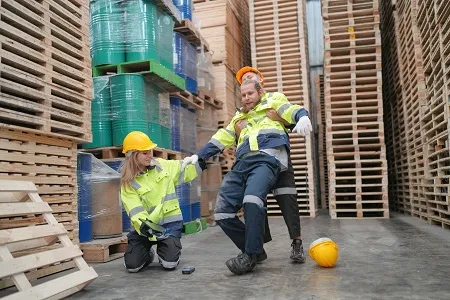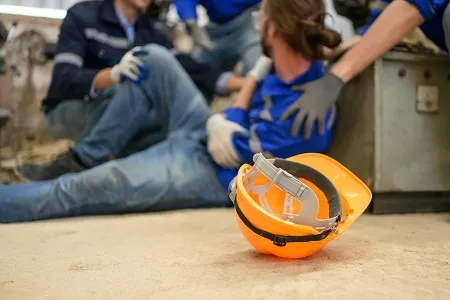Avoiding workplace accidents
Statistics estimate that workplace injuries cost Australia’s economy around $60.6 billion annually, which is 4.8% of the total GDP. Apart from the worker being incapacitated to continue earning a living, businesses are sometimes forced to pay fines amounting to thousands of dollars. While industries such as mining and construction have a higher workplace injury rate, working in the office does not necessarily mean that the employee is not prone to accidents.
Australian Compendium of Workers’ Compensation Statistics and the Australian Bureau of Statistics (ABS) list the following as the most common causes of workplace accidents and how each can be prevented:-
- Sprains and strains
These injuries are common where workers have to lift, push, or carry heavy objects. Safe Work Australia estimates that injuries due to sprains and strains of the joints and muscles account for around 42% of all workplace accidents. Such injuries are typically due to poor equipment handling practices due to lack of proper training.
Workers should be trained on proper lifting techniques such as keeping the heavy object close to the body or not attempting to move anything that’s beyond their physical strength.
- Slips and falls
Majority of workers’ compensation claims are due to slips and falls which result in fractures, dislocations, tissue disorders, open wounds or lacerations, and contusions. Common causes of slips and falls are:-
- Oily or wet surfaces
- Occasional spillages from coffee, equipment lubricants or even water
- Uneven floor
- Poor lighting
- Power cables or phone jacks lying loosely on the floor
- Loose rugs and mats
Good housekeeping is one way of preventing trips and falls. Workers should also be provided with proper footwear and be made aware of the consequences of not wearing them. They should be encouraged to report if they notice any spills, obstruction, clutter, and damaged floors. Ensure that you print out a signage for slippery areas or wet floors. Keep the environment safe by ensuring that there are no loose cables. Also, keep away objects that are not being used. Apart from keeping the workplace tidy, this minimises the chances of an accident.
- Repetitive motion injuries
The use of computers in workplaces has had its effects on the employees. More and more employees are complaining of eyestrain, spinal injuries, cumulative trauma disorder, and bodily pain.
Such injuries can be prevented by updating the workplace to ergonomic standards. Computer work should also be allocated evenly across the entire staff so as to allow for regular breaks. Encourage your employees to maintain a healthy lifestyle and exercise. Teach them on the need to maintain a good posture when sitting or standing.

- Injuries from falling objects
Construction sites are not the only place where injuries from falling objects are encountered. Loose shelves or other storage facilities at the office could also injure unsuspecting employees.
Workers in construction sites should be taught on the need to always wear protective gear such as helmets. In the office environment, avoid over stacking files and other objects. Designate isolated storage areas to minimise employee exposure to potential accidents.
- Accidents caused by vehicles and workplace equipment
Vehicle accidents are the primary cause of terminal injuries in Australia’s agricultural sector. Workers could get injured either on the road or at the workplace. Machine-related injuries are common in the manufacturing sector and industries. Such injuries include severed limbs or fingers, crushed arms or legs, deafness, blindness, being struck by flywheels and other machine components, and so on.
Vehicle and machine-related injuries can be prevented by first assessing who is at risk and the most likely accident prone areas. After this, prevention measures such as worker orientation and setting up of safe work systems becomes easier. Layout rules such as speed limits and routes that segregate company vehicles and pedestrians. Mark any obstruction and work on a clear workplace design.
- Mental stress and illness
Stress and mental illness are often overlooked as it is not a physical injury and therefore, it’s not visible. Unrealistic demands at the workplace often lead to depression, anxiety, or other mental health challenges. According to ABS, 45% of Australia’s population aged 16 to 85 experience mental illness at one time or the other in their lives.
Mental stress can be effectively dealt with through workplace counselling. This gives the employees an opportunity to discuss the stressful workplace or personal issues that might be wearing them down, and a secure space for healing and insight.
- Fires and explosions
Although burns at the workplace make up 3% of the total workplace injuries, they should not be taken lightly. Fires and explosions are often a result of poorly stored flammable materials, open flames, poor fitting of pipes, and defective gas lines. Apart from burns, employees could also damage their respiratory systems.
Such injuries can be avoided through proper labelling of flammable equipment and chemicals. The MSDS (Material Safety Data Sheets) for all chemicals should be easily accessible at all times. Encourage the employees to always wear personal protective equipment at the workplace.
- Assault or violence
While this form of injury is seldom spoken of, it does happen. Workplace harassment, bullying, and assault could lead to aggression and violence. It also causes high staff turnover, chronic absenteeism, and low productivity.
This can be tackled through the provision of a platform or forum where workers can give feedback on the workplace environment. Put in place processes where harassment and bullying can be reported and dealt with. Train the employees on how to handle stress in the workplace.
How Induct for Work can help reduce workplace injuries
Workplace related injuries can be minimised or prevented when utilising our online induction platform – Induct for Work. As opposed to other safety training methods which are often costly, disruptive, and time-consuming, Induct for Work enables your employees to access your uploaded online training materials at any time. Through the platform, you can train your employees on:-
- Company policies and safety procedures
- Site evacuation procedures in case of fires and explosions
- Safe manual handling of equipment and machinery
- The importance of wearing personal protective equipment and the consequences if one is found not wearing them
- Safety precautions and first aid procedures in case of an accident
- Accidents or near-miss reporting processes and procedures
You can upload new training material should there be a change in processes, equipment or even job responsibility. Uploading online inductions or any other training material on Induct for Work ensures that all your employees receive similar information and therefore, a consistent training experience. Contact us for more information on online inductions.
Do you have any questions or great tips to share?
Induct for Work – the only online induction system you would need to run online inductions.



